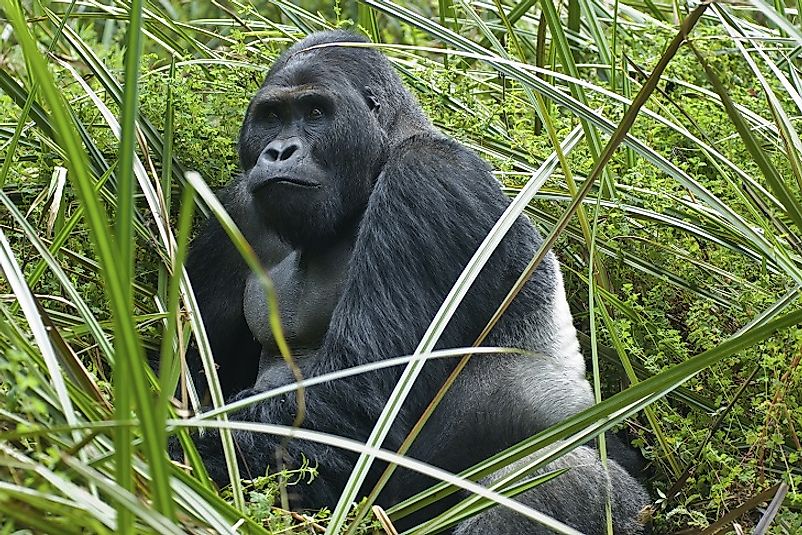Why Are Grauer’s Gorilla Populations So Threatened?

5. What are Grauer’s Gorillas?
The Grauer’s gorilla (Gorilla beringei graueri), also known as the Eastern lowland gorilla, is a subspecies of the eastern gorilla that is endemic to the tropical forests of the Democratic Republic of the Congo (DRC) in Africa. Males of this gorilla subspecies have an average weight of around 163 kilograms, while females are only around half of mass. The gorillas have a jet black coat which turns silvery at the back in the case of males as they mature. These gorillas are the largest of the four gorilla subspecies. Males have an average height of around 1.69 meters, while females have an average height of around 1.60 meters.The Grauer’s gorillas are distinguished from other gorillas by their stockier builds, shorter muzzles, and larger hands.
4. Life in the Eastern Lowlands
The Grauer's gorillas are found in the mountainous, transitional, and lowland tropical forests of the DRC. The most thoroughly studied populations of these creatures occur in the Kahuzi Biega National Park. Other populations are found in the Maiko National Park, the Usala Forest, the Tayna Gorilla Reserve, and around the Itombwe Massif. The Grauer's gorillas are primarily herbivorous in nature, feeding on the leaves, stems, fruits, and bark of native plants. Occasionally, these creatures might resort to feeding on insects as well. The gorillas form highly social groups of 2 to 30 individuals, wherein a single dominant male or two full-grown males lead a group of several females and their offspring, being responsible for protecting the group against all forms of danger. Young, maturing males leave such groups in the hope of attracting females to form new groups of their own one day. The Grauer's gorillas have a gestation period of eight and a half months, quite close to that of a human being. The babies breastfeed for 3 years, and males mature at about 12 years of age, while females do so at an age of around 8 years.
3. Ravaged By War
For years, the Democratic Republic of the Congo (DRC) has suffered from the ravages of civil war raging in the region. Currently, though there have been some improvements in the war scenario in the country, the eastern parts of the DRC still remain under the influence of dozens of armed groups and rebels whose activities have put to stake the life of humans and the wildlife inhabiting the forests of the region. The Grauer’s gorilla, one of the largest species of mammals inhabiting the forests of the eastern DRC, became highly vulnerable to the effects of human greed and exploitation as proper conservation methods are difficult to implement in the war-torn region. What is worse still, the Wildlife Conservation Society reported the death of a forest guard in the Kahuzi-Biega National Park at the hands of the treacherous armed rebels as recently as March 31st, 2016. This being the only site where the gorilla numbers appear to be recovering, the murder of the guard appears like an ill omen for the prospects of the future survival of the species.
2. Poaching and Deforestation
The Grauer’s gorilla now occupies only 13% of the species’ historical range. Per a 2016 report, only 3,800 of these gorillas exist in the wild today, while only a few decades back in the mid-1990s, there were 17,000 of these same gorillas in the forests of the DRC. The civil war has triggered the loss of large areas of the Grauer's gorillas' habitats in the absence of sufficient scope for implementing protective measures by the government of the DRC in its most war-ravaged zones. Widespread poaching of these great apes has also greatly diminished their numbers in the forests. Mining for coltan, a key mineral used in the manufacture of mobile phones, has also impacted the habitats of these apes.
1. Conservation Efforts
Like many other wild species inhabiting the world today, the Grauer's gorillas have been pushed to the brink of extinction by human greed and selfishness. With civil war in the DRC showing no signs of permanently stopping, the situation for these wild gorillas appears quite grim. The World Wide Fund for Nature, Flora and Fauna International, the Wildlife Conservation Society, and other such organizations are working together with the DRC's government to devise plans and methods to guard the last remaining Grauer’s gorilla families. Discussions on creating a true "green" beret, or a section of the country’s army trained to protect the forests from the armed rebels, are underway. There is also a great need to create awareness among the locals of the region to stop hunting down these gorillas for the consumption of their bush meat.











